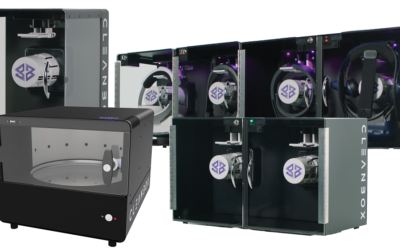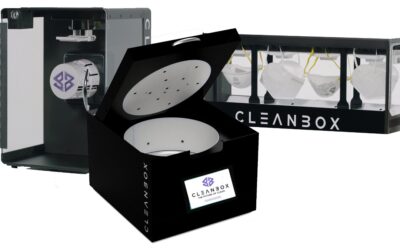VR headsets have endless uses in the education, healthcare, and government sectors. As these high-tech devices become universally used, it’s essential to have an appropriate hygiene plan established. Improperly performed VR headset cleaning and decontamination can damage valuable equipment and cause pathogens to be transmitted between users. UVC units are a contemporary and economical method of ensuring user safety through a hospital-grade clean.
Until recently, disposable wipes have been the default cleaning method for headsets and other shared electronics. Unfortunately, wipes are not only an inferior cleaning product, but they are also wasteful from both a physical and financial standpoint. In addition, wipes cannot be scaled to meet the needs of industries that regularly use VR equipment and shared electronics, leaving the healthcare, education, and government sectors desperate for an alternative solution.
Decontamination of VR headsets at Scale
When implementing AR technology in an educational or operational capacity, VR headset cleaning is a factor that is often overlooked. However, the Coronavirus pandemic demonstrated the dangers associated with shared equipment and how quickly pathogens can spread. To limit the spread of disease, enterprises and educational institutes must have a standard operating procedure for the disinfection of headsets and shared electronic equipment.
Maintaining cleanliness standards in small enterprises can be challenging. Still, the limited number of individuals using a given piece of equipment allows businesses to feel in control of their decontamination practices. On the other hand, large-scale operations such as hospitals, government offices, and education spaces will find themselves dealing with unwanted complications if they utilize advanced technology without an equally advanced disinfection system.
VR Headset Cleaning: Comparing Options
A hygiene solution cannot be considered scalable unless it can adapt to the needs of a given enterprise. Determining the best solution for disinfection on a large scale requires looking at multiple factors.
First, the affordability of the solution and whether it is feasible long-term. Second, the impact the disinfection method has on the equipment, user, and environment. Finally, and most critically, whether or not the disinfection solution is effective and verifiable.
By comparing disposable wipes to Cleanbox’s UVC sanitizing systems, it is easy to identify which disinfection option can be scaled to suit the needs of operations of all sizes.
Expense and Longevity
Disposable Wipes
Wipes fall short when it comes to being an economical long-term disinfection option. Since wipes are a single-use product, and thoroughly cleaning a headset requires several wipes, groups choosing to use this disinfection method will be caught in a perpetual loop of purchasing wipes. In addition to the expense of the wipes themselves, organizations will also lose money due to the time it takes to clean a headset with a disposable wipe.
Adequate headset cleaning with an alcohol wipe can take up to eight minutes when the disinfection is completed correctly. In addition to carefully cleaning around all the various components, the individual responsible for the cleaning must also ensure the surface is wet with disinfectant for the appropriate amount of time. When cleaning multiple headsets numerous times a day, the cost of purchasing and using disposable wipes makes them a costly option.
Cleanbox UVC Units
Using a Cleanbox unit to sanitize headsets requires only the cost of purchasing the machine. Each Cleanbox unit lasts approximately 10,000 hours, or 600,000 cleaning cycles, making them 30X less expensive than disposable wipes. UVC units offer organizations the ability to scale disinfection practices to meet their current need without incurring additional charges. They also offer significant time savings.
Each cleaning cycle runs for just 60 seconds, and all the user needs to do is load their headset into the machine, press the button, and retrieve it at the end of the cycle. No waiting for disinfectants to dry or wasted minutes working a wipe into every crevice on a headset. Additionally, for operations looking to maximize every minute, the CX series by Cleanbox features units built to hold numerous headsets so that more than one device is cleaned each cycle.
Impact
Disposable Wipes
The housing on most headsets can’t handle exposure to harsh chemicals multiple times a day. Increased deterioration speed means replacing headsets more frequently. Chemicals found in disposable wipes can also present a danger to the individuals who come into contact with them. Individuals with sensitivities may find the cleaning agents in the wipes contribute to migraines, irritated skin, or even asthma attacks.
Finally, disposable wipes have a negative impact on the environment that cannot be overlooked: wipes, even those touted as biodegradable, are resistant to decomposition. By using eco-friendly disinfection solutions, operations can avoid contributing thousands of disposable wipes to the massive amounts of trash in landfills.
Cleanbox UVC Units
Each Cleanbox unit is self-contained, creates no waste, and leaves behind no residue. The common concerns associated with wipe use are non-existent, as the LED UVC light used in Cleanbox devices is metered to eliminate pathogens without causing damage to headsets and other electronics. When users remove their headsets from the decontamination chamber, they will not have to be concerned about irritating residue or potentially dangerous chemicals.
Additionally, Cleanbox systems are an environmentally-conscious method of sanitizing equipment. Since they only use UVC rays as a disinfecting agent, they are capable of cleaning devices to hospital-level standards without creating waste.
Effectiveness
Disposable Wipes
Testing has shown disposable wipes to be ineffective at eliminating viruses and bacteria on headsets and electronics, even when used under ideal conditions. Since replicating ideal conditions in the work or education spaces is unlikely, most disposable wipes provide only a false sense of clean and minimal decontamination benefits. A false sense of security in government, education, and healthcare spaces will create dangerous situations.
It only takes one contagious user to discover how critical it is that decontamination methods are verifiable and do not rely on user skill or diligence. The larger an organization is, the higher the risk of disease being brought into the building, which means operations increasing staffing or increasing how often they use headsets will want to use a cleaning solution that is up to hospital standards for optimum defense against virus transmission.
Cleanbox UVC Units
Cleanbox UVC units work by using globally-patented LED UVC rays at a specific nanometer range that disrupts the genetic material of viruses, bacteria, and fungi. Once a headset has been placed inside the cleaning chamber, every single millimeter of the headset will be exposed to target UVC rays at the required intensity for the necessary amount of time. This disinfection cycle results in a pathogen elimination rate of 99.999%, considered hospital grade.
Ensuring equipment is cleaned to hospital standards is a way for operations to protect staff, students…and themselves. When an organization uses hospital-grade disinfection equipment on its shared devices, even the most litigious individual will be unable to claim negligent behavior led to their illness.
Scalable Hygiene Solutions
The larger an operation is, the more impractical it is to use disposable wipes, as they cannot work at scale in sectors like education, government, and healthcare. Additionally, disposable disinfection options should never be considered for long-term use, as they create unnecessary financial and physical waste and do not provide a reliable level of disinfection.
UVC light boxes offer an economical option for operations looking for a cleaning solution capable of adapting to their needs without creating additional expense or waste. Cleanbox units also provide a hospital-grade clean that prevents user error from putting users at risk. Schedule an online demonstration to discover why over 2,000 enterprise clients use Cleanbox UVC systems in the healthcare, education, government, and manufacturing sectors. Contact Cleanbox today.





